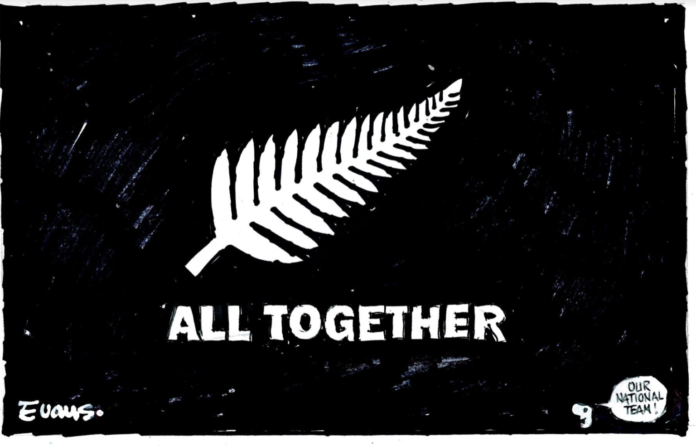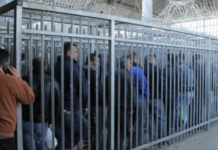One of the ways of looking at this crisis and what must be done to deal with the effects is to look at how governments around the world confronted their enemies in wartime.
This first thing to notice is that they did not rely on the so-called efficiency of the market to deliver results. Early attempts were made to use inducements rather than orders but this approach was soon abandoned.
The governments simply assumed control of production and ensured every aspect of society was subordinated to the one goal of defeating the enemy.
The enemy now is a virus and an economic collapse that have become intertwined.
Defeating the virus is a pre-condition for economic recovery but the state has to take the lead in both processes and nothing can be left to the market and the pursuit of profit which is the only logic of the economic system we live under and know as capitalism.
The world knew a pandemic was inevitable yet health systems in most countries, including New Zealand, had been allowed to decline to a level when even a winter flu which they knew would come every winter would overwhelm them.
This is explained well by Noam Chomsky in a recent article headed Chomsky On Coronavirus: Why Neoliberalism And Big Pharma Can’t Respond.
New Zealand’s per capita level of ventilators and ICU beds were amongst the lowest in the world.
Gordon Campbell deals with this is an excellent article headed: On Our (Fatal?) Shortage Of Ventilators
The March 18 New Zealand Herald reported that:
The number of ICU beds per population in New Zealand has fallen steadily over the last 20 years, with the country now well behind comparable countries, including Australia.
The Ministry of Health has acknowledged the current capacity might not meet demand for a widespread Covid-19 outbreak and on Tuesday announced a $32 million boost, though experts question if it will be enough to bridge the gap.
The article noted that the situation had got worse in recent years in New Zealand despite the alarm bells going off around SARS in 2003 and MERS in 2015 which were also coronaviruses. “Between 2011 and 2018, the rate per 100,000 people declined from 5.98 to 5.14, whereas in Australia it increased from 8.50 to 8.92.”
In Europe the average is about 11.5, with Germany having close to 30.
The low level of facilities was identified in an official Ministry oh Health report in 2005 headed: INTENSIVE CARE SERVICES IN NEW ZEALAND: A Report to the Deputy Director-General, Clinical Services, from the Intensive Care Clinical Advisory Group
Workers need personal protection equipment. Patients will need ventilators and beds. Companies with the ability to make and deliver them should be ordered to do so immediately.
For 150 years, capitalism has always been a system that breeds inequality, racism, war, oppression and exploitation. That’s enough for me to want to end this system. Recent decades have revealed the fact that this system is also incapable of coexisting with the needs of the planet itself as a consequence of global warming and climate change.
The coronavirus has added a new level of urgency. The health care systems of even the richest capitalist countries were ill-equipped to deal with the problem. This was compounded by the fact that capitalism is based on the production of commodities that must be sold for a profit meant that the owners of capital were extremely reluctant to take the public health measures that are needed, in particular shutting their businesses. Work in major export manufacturing in most countries was allowed to continue.
Irish socialist John Molyneaux identifies another reason that capitalism is ultimately the source of the viral epidemics also in an article headed “System Change: Now More Than Ever”:
The coronavirus is not an ‘act of God’ or a natural disaster, nor is it a one off. Rather, it is a consequence of a much deeper crisis in the relationship between human society and nature that has been brought about by capitalism. It is part – the most immediately deadly part – but in the end still a part of the wider rift with nature that also brings us: the clogging of the seas with plastic; the progressive acidification of the oceans; the developing scourge of air pollution in so many cities; and, above all, the threat of catastrophic climate change.
Specifically, the coronavirus is the latest and worst in a series of viral crises including HIV, H5N1 (‘Avian flu’) in the late 90s, H1N1 (‘Swine flu’) in 2009-10 which claimed up to 500,000 lives, MERS (Middle Eastern Respiratory Syndrome) in 2012 which did not spread widely but had a very high death rate, and Ebola in 2013-16.
As epidemiologist, Rob Wallace, has shown in his book Big Farms Make Big Flu, this epidemic of epidemics is a combination of two things that are driven by capitalism – encroachment into the wild and industrial farming methods:
-
- These viruses originate among wild animals. There is an unknowable number of them because they mutate. In the past we would have been less likely to come into contact with many of them, but as deforestation and further encroachment into the wild happens, we are more likely to come into contact with animals that carry these viruses.
- Industrial farming of animals is happening now on a colossal scale, and it’s increasing. The manner in which these animals are farmed lends itself to disease spreading very quickly. The animals are kept in very close proximity. They also have very little genetic variation, so the immune systems of the animals will have roughly the same response. If one animal catches a virus it is likely to spread like wildfire to all the others. Also, the response to disease is often to slaughter the animals – this means that all of them are slaughtered, and any that might have developed a resistance to disease go with them. Once the virus makes its way to farm animals, it’s a much shorter hop to humans than it would have been from the wild.
The truth is that unless we change our method of farming, and that cannot be done on the scale required without changing our economic system, we are looking at the truly terrifying prospect of recurring and ever-more-deadly viral pandemics.
But we need system change to do that.
A new system must be based on producing goods for need, not profit. We cannot go back to the old ways of farming and producing goods that involve exploiting the planet without limit.
Already companies are announcing closures or mass layoffs and pay cuts. These companies need to be brought back into the hands of the state and placed under workers’ control and management to repurpose them to the needs of tomorrow. We can’t just allow them to fail.
Air New Zealand is already state-owned and needs to become a much smaller airline for the planet’s sake but we should hold onto the skilled workforce and find new ways of doing things including in the air that is less destructive. If workers need to transition to other jobs then this should happen with a plan and the incomes of these workers protected. The workers should be given at least half the seats on the board to make that happen.
How this was done in the US in World war Two is explained by another Irish socialist very well and I would like to quote the article headed “It Can’t Be Done”:
Japanese airplanes bombed Pearl Harbour on December 7th, 1941. By Xmas, the US economy had been put on a radically different footing.
“It is not enough to turn out just a few more planes, a few more tanks, a few more guns, a few more ships than can be turned out by our enemies,” President F.D. Roosevelt told the country in a radio broadcast on December 10th. “We must out-produce them overwhelmingly, so that there can be no question of our ability to provide a crushing superiority of equipment in any theatre of the world war.”
In 1939, the United States army ranked 39th in the world in terms of military power. The country had not been involved in major conflict since the end of World War One. Its dominant ideology anathematised foreign intervention.
Now, suddenly, the president was setting staggering targets and a giddy change of direction for military production. He dispatched a flurry of orders to owners of industry, trades union leaders, newspaper editors, party bosses, state legislators, etc. – your country needs you to stop what you are doing and join in a mighty effort to equip America to prevail in a global conflict.
The US went on to produce 60,000 aircraft in 1942, 125,000 in 1943, plus 120,000 tanks and 55,000 anti-aircraft guns in the same period – and trained a vast force to use them.
Industries were not asked or urged to meet these targets, but directly instructed. Managers and workers were effectively conscripted.
Roosevelt decreed that all car manufacture was to cease “right now.” In 1941, the US manufactured more than three million cars. Between Roosevelt’s speech and the end of the war in 1945, 139 rolled off the production lines. (Not a misprint: 139.)
General Motors was told to switch immediately to making airplane engines, guns, trucks and tanks. Chrysler was to specialise in fuselages. Ford began frantic re-tooling. The average Ford car, the Model T, had some 15,000 parts. The airplane Ford was now instructed to make – the B-24 long-range bomber – had 1,550,000. By mid-1942, six months after Roosevelt’s speech, B-24s were trundling off the line at a pace of one every 63 minutes.
It can be done.
Shipyards turned out vessels at such a rate that by the autumn of 1943 all Allied shipping sunk since 1939 – US, British, Australian etc. – had been replaced. In 1944, the United States built more planes than the Japanese managed to do during the entire course of the war.
By the end of the war, more than half of all industrial production in the world was taking place in the US and around 80 percent of this was war production.
America was transformed at a pace and to an extent which would have been dismissed just months previously as beyond the range of possibility. It was this, more than any other factor, which was to win the war – the production of what was needed for victory in the quantities and the time required.
It was this which set the US on the road to becoming the world’s super-power.
As many as 16 million men and women were recruited, trained and shipped off to war. Half as many again, 24 million, poured into the defence industries back home – many earning more than they would previously have dared ask for.
Eighteen million women entered the workforce. African Americans and Latinos were brought in for the first time. Union officials policed production.
At the beginning of the war, Gulf Shipbuilding employed 240 men. By 1943, the number had risen to 11,600. The Alabama Dry Dock company went from 1,000 workers to 30,000 in 14 months. In Connecticut, the medium-sized Mattatuck Manufacturing Company switched overnight from making upholstery nails for furniture to cartridge clips for Springfield rifles – three million a week.
The American Brass Company, known for plumbing parts and decorative devices, began producing brass rods and tubes for weapons. The Chase Brass and Copper Company made more than 50 million cartridge cases and mortar shells and more than a billion bullets.
And so on. Patterns of production changed out of all recognition. It can be done.
A union official in Alabama recalled factories clanking and whirring around the clock. “For the workers, it was seven days a week, 12-hour days, 10 hours on Saturday, eight hours on Sunday, on and on, in and out, over and over and over and over again.
“The one thing was to produce material to win the war.”
The economy boomed to dizzying heights. The Depression disappeared in the slipstream of rocketing manufacture. The US was to end the war as the most powerful economic and military force in the world, and with a society different in dozens of ways.
The massive movement of African Americans from the South into Northern industrial centres like Chicago and Detroit generated a cultural as well as an economic shift. New sounds eddied out. It was thus that Motown was born.
Capitalist society had changed but had not been overthrown. Some things stayed the same. Jim Crow still skulked. Women remained oppressed. The gulf between the rich and the rest yawned wide. But many of the changes which happened were to prove irreversible. Things hadn’t quite returned to normal. “Normal” was gone.
It wasn’t that everything changed for the better but that everything changed, some of which was for the better and which we managed to retain.
What had generated this altered state was that the imminence of an existential threat had smashed into the consciousness of a relatively enlightened leadership of the US ruling class which responded as rapidly and appropriately as capitalist thinking allowed.
This is not an exact model for moving forward now. But it has lessons for now which it’s useful to think on.
Can we match the soaring leap in production of armoured cars and ships and ‘planes under Roosevelt with a hike the likes of which has never been witnessed in production of ventilators, masks, protective clothing, testing units and whatever else the NHS tells us we need?
Can we switch en masse into new areas of manufacture appropriate to the scarifying age we live in?
Can we create comprehensive high-quality, home-based education system for now and for future generations?
Can this generation mimic or even outdo the shift in attitudes and assumptions in the US in the 1940s?
Yes, we can. It can be done.
Who will argue now that the future of our society, even of our civilisation, is contingent on ceding power to a super-clever elite rather than on the sweat and genius of the working class?
What class of people would now dare deny a nurse’s pay claim? Or insist that our public services must give way to private enterprise, that need must wait on greed, the market let rip through every aspect of our lives?
In face of the coronavirus pandemic, eternal orthodoxies have become old hat.
Ideology has been twisted back into shape.
However things work out in the coming days, weeks, months, years, struggle will continue at ever deeper levels. It is through the experience of struggle that we will shape the world anew. The defenders of the old order haven’t gone away, but have hunkered down to wait for their hour to come again.
If we steady ourselves, keep focus on the obdurate truths of class conflict, evident through the fog of fear and confusion in and around us, we will better see the outline of the terrain on which we will have to fight.
McCann concluded his article by paraphrasing German socialist leader during World War One. “We will have socialism or barbarism, Rosa Luxemburg warned. Her truth has never loomed so large.”
I can only concur






Bloody well said Mike;
Our family fully agree that the rich elite don’t care a damn about our wellbeing and humanity; – and the sweat of the working poor, being suppressed for their proifit driven callious greed.
Also NZ needs to learn to collect real data and have real scientists instead of idiot marketing and going for the easiest, cheap data for statistics. We have descended into pop science in NZ for decades now. It is laughable!
Example, Google data being used to map lockdown locations being promoted by MSM. This is laughable to be used as a statistic as it only measures those with Google phones (not iPhones) and you have to have signed in to track location. So it’s the usual junk science statistics that NZ government and MSM loves to promote! Just like the fake Meth levels! And the disaster of Census that managed to marginalise Maori in particular!
Bad data and the use of bogus statistics is dangerous. Aka
Health care spend was declining in NZ per capita well before Corvid-19. While the government was pretending they were injecting large amounts of money into the health system nobody called out (either the media or the health sector or the lefties) that it was actually still reducing the spend of health per person in this country because they had not increased the health spend at the rate they needed to, with their immigration drive into NZ.
If the government bothered to use proper experts and data and the relationships of data to results instead of fake, easily obtained, data, analysed and distributed by idiots, then NZ would be able to understand and safeguard itself a lot better!
Think of the damage being done in NZ from the fake Meth levels evicting people and creating a fake industry, the disaster Census that is useless and we have zero idea what is going on here from 2013 (and A LOT has changed since then) and now misleading lockdown data being distributed on all the MSM channels!
No Mike, we don’t want communism. Because thats what you are REALLY advocating for in this longwinded sanctimonious article.
Freedom is dangerous….. I would rather have dangerous freedom than your safe “safe” slavery….
And dummies like you Ross dont even know the difference between Communism and Socialism. That is the problem with the ‘right’. What a waste of a tertiary education.
Freedom for some with money and power to enslave is not freedom for all.
God ! That was amazing stuff. Thanks @ Mike Treen.
I’ve come to think of ‘capitalism’ as a demonic blend of fascism and authoritarianism. Instead of one Big Poop hitler strutting about, we have many billionaire hitlers prancing about while walking over the rest of us and when the inevitable shit hits the fearsome fan they fuck off to their hide-away survivalist bunkers.
Re industrialised farming?
You’re dead right.
When one adds the word industrial to the word farming one gets a looming catastrophe.
I think of farming as being similar to a musical instrument. One has to learn to tune it properly to get the best sound possible. Actual farmers know their land. And that land can differ significantly from farm to farm, district to district, county to county. Bankers know nothing about farming but they know everything about capitalism. Politicians know nothing about farming either.( Unless a politician was a one time farmer. The very worst kind of politician and the greediest. )
Only farmers who’ve farmed intergenerationaly know that.
Our agriculture is of primary urgency. Our agriculture is in tatters and in dire need of a de lousing of the artisan crooks who’ve been sucking our agriculture dry for generations.
You wrote about the mammoth tasks faced by the Americans during the war effort.
12 hours a day five days a week, then 10 hours on Saturday then 8 hours on Sunday.
But where were their breakfasts, lunches and dinners coming from? The bank?
If high quality foods ( and wines please?) was a guaranteed supply we’d be safe and happy.
As someone wrote:
“All else would be art”.
There are good videos on Youtube about how things were done in WWII e.g. this one which is very nuts and bolts focused https://www.youtube.com/watch?v=_t3akMEm9bI and this one (@countryboy) which describes child-care, housing, medicine and training and the building of a whole new town around industrialist Henry J. Kaiser’s brand-new wartime shipyard at Richmond, California: https://www.youtube.com/watch?v=LUm6xjXq3MU&t=1549s in the section that lies between 13 and 22 minutes in.
Kaiser was a sort of American equivalent of NZ’s James Fletcher at the time, and (with quite similar govt backing) went out of his way to make sure the workers were well looked after. A bit like NZ in the State Housing era. As McCann says, “it can be done.” But you can expect the Rogernomes to squeal like hell because it also, basically, implies a Think Big approach. Heh heh, as the shade of Rob would chuckle.
The world knew a pandemic was inevitable yet health systems in most countries, including New Zealand, had been allowed to decline to a level when even a winter flu which they knew would come every winter would overwhelm them.
Just in Time is our song for today. Ella Fitzgerald sings it well. (https://www.youtube.com/watch?v=TZk1dJc2B5I
Can we declare Gordon Campbell to be an essential service and fly him to the Parliamentary Press Gallery immediately?
I watched the government tell us there was plenty of spare capacity in the testing systemm while hearing anecdotal stories from people who had been told they wouldn’t be tested because they couldn’t prove an international connection. Every journalist in the country should have been asking the obvious question that this brings up but as usual Gordon Campbell seems to be the only one capable.
Unless of course the other news outlets are trying really hard not to cause any more panic after their appallingly hysterical start to the coverage of this crisis
How Business As Usual Works. (or doesn’t as this case shows).
The US Navy hospital ship ‘Comfort’ with 1,000 beds and 12 operating rooms has been sent to New York with much fanfare. Presiident Trump was there for the send off.
Since the Comfort docked in New York a week ago only 20 patients have been let on board. None of them Corona virus victims.
Why?
Because the ‘Comfort’ is a war ship.
It has to be kept ready in case the US decides to go to war.
If patients infected with Covid-19 are ever taken on board the comfort to be treated, the whole ship including the many miles of air conditioning ducting would have to be decontaminated.
Costing $millions and delaying any deployment to a war zone by many months.
The primary purpose of the Comfort is not to save lives. The primary purpose of the Comfort is to keep American troops at the front of any conflict the US chooses to involve itself in.
When you run your health system on minimum resources and beyond maximum per person hours you have no leeway. It’s done to minimize the cost and maximize the left over money for profit.
America is already a command and control (non market forces) economy. They inwardly invest huge amounts of public money in their core industry, it’s just that they have rigged the system to allow that core industry to be subsidized without the risk of WTO interference. The defense (AKA war) industry.
I think the real challenge is how do we get from here to there (and better society). The rich went in the other direction by being sneaky and manipulating our greed. I wonder if there is a better way to get back, one that doesn’t involve draconian class war measures like suggesting we tax all baby boomers retirement investments – probably a deliberately stupid suggestion to get rid of any suggestion of capital gains tax. I believe the rich are happy to have a larger slice of a smaller pie (post 1970s neo liberal economy), but I’m not sure they want to be kings of an anarchy ash pile.
Maybe we can get round all these sovereignty busting trade regulations by rebuilding our defense industry. What greater protection of the country than to have huge medical (for handling flu, pandemics etc) and engineering (for building infrastructure like train lines etc) corps. We’re not being socialist we’re being good old defense industry neo liberals.
Comments are closed.